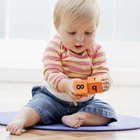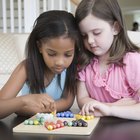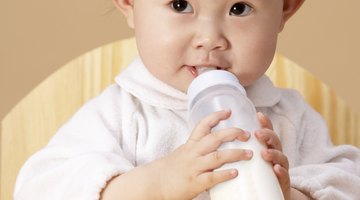How Does a Baby Rattle Help With Cognitive Development?
Baby rattles might not look like much fun to an adult, but these ordinary infant playthings spark an array of sensory experiences for a baby. A simple rattle can amuse and engage your baby as well as aid in his development. By integrating rattles into daily playtime with your baby, you can promote and strengthen your child’s motor abilities and help him reach cognitive milestones, which involve his ability to think and reason.
Hand-Eye Coordination
Hand-eye coordination is essential to an infant’s eventual ability to grasp and hold objects. It is a skill that children continue to develop throughout childhood, as they learn to feed and dress themselves, write with pencils and perform more complicated tasks, such as riding a bicycle. This skill begins with your infant’s ability to recognize, perceive, track and watch movement, notes the American Optometric Association. During the first few months of your baby's life, you can aid in the development of this skill with practice exercises using a rattle. Slowly move the rattle across your child’s field of vision, encouraging her to track the rattle with her eyes as it moves across her line of sight. This technique also encourages focus and attention.
Perception

Intellectual Development of Babies
Learn More
Babies need opportunities to perceive sights, sounds, tastes, smells and textures to develop their abilities to make sense of the world around them and come to understand it. Rattles can aid in perceptual development. During the first three months of your baby's life, you can shake a rattle to help her experience and perceive sound. Encourage textural perception by gently dragging a soft rattle across a baby’s cheeks or down his legs, so that he becomes familiar with touch and starts to comprehend differences between touches and textures.
Sensorimotor Skills and Cause and Effect
Sensorimotor skills involve receiving sensory messages and producing a response. We receive sensory information from our bodies and the environment through our sensory systems, which include vision, hearing and touch, but we must then organize the information and process it. Baby rattles are useful tools for fostering sensory processing and motor output. At 4- to 7-months old, your baby will likely hold the rattle herself, notes HealthyChildren.org, a website of the American Academy of Pediatrics. Place the rattle in her hand and assist her in shaking it to produce its distinct sound. She will remember that when she shakes the rattle, it makes a sound, perceiving the idea of cause and effect, which is a cognitive concept.
Object Permanence

Activities That Promote Physical, Cognitive & Creative Development
Learn More
Object permanence, another cognitive concept, is a baby’s ability to realize that when something is out of view, it doesn’t cease to exist. Encourage your child’s understanding of this concept with a baby rattle and a blanket. Sit with your infant and place the rattle on the floor in front of you. Playfully hide the rattle under the blanket and after a few seconds, lift the blanket up to reveal the rattle beneath it.











